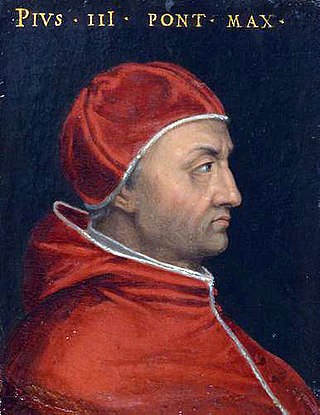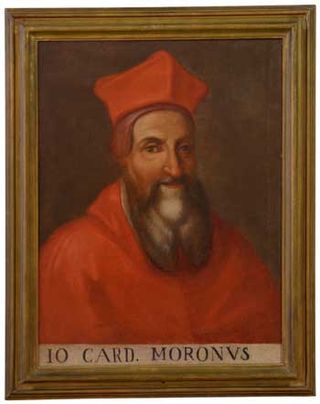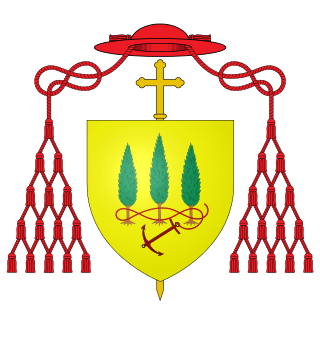
This article relies largely or entirely on a single source .(December 2022) |
Amico Agnifili (died 1476) (called the Cardinal of L'Aquila) was an Italian Roman Catholic bishop and cardinal.

This article relies largely or entirely on a single source .(December 2022) |
Amico Agnifili (died 1476) (called the Cardinal of L'Aquila) was an Italian Roman Catholic bishop and cardinal.
Amico Agnifili was born ca. 1398 in Rocca di Mezzo, the son of a poor shepherd. [1] (His family had not yet adopted a family name, so when he was elevated to the cardinalate, he chose the name of "Agnifili", meaning "Friend of the Lamb".) [1]
His father sent him to L'Aquila to be educated. [1] He later studied in Rome under Cardinal Domenico Capranica. [1] Later, at the University of Bologna, he was a schoolmate of Enea Silvio Piccolomini, the future Pope Pius II. [1] He received a doctorate of both laws. [1]
He then returned to L'Aquila, becoming a canon of San Massimo Cathedral and archpriest of San Paolo di Barete. [1] He then moved to Rome and was named a canon of the Basilica di Santa Maria Maggiore. [1] He then became a professor of law at the University of Bologna, where one of his students was Pietro Barbo, the future Pope Paul II. [1]
On 23 May 1432 he was elected Bishop of L'Aquila. [1] While bishop, he served as a counselor to Alfonso I of Naples and his successor Ferdinand I of Naples. [1] Pope Eugene IV named him papal legate to attend the coronation of Sigismund, Holy Roman Emperor in Milan. [1] He later served as legate several other times, including once as legate to the Patrimonium Sancti Petri . [1] Together with Giovanni da Palena, Bishop of Penne, he was the commissary responsible for the canonization of Bernardino of Siena. [1] He was also visited by John of Capistrano. [1] When the city of L'Aquila rebelled against Ferdinand I of Naples, Bishop Agnifili sided with the rebels, which angered Pope Pius II. [1] The rebels returned to their obedience in 1464. [1]
Agnifili's former student, Pope Paul II, named him general treasurer of the church in the Marche. [1] In the consistory of 18 September 1467, Pope Paul II made him a cardinal priest; he received the red hat in San Marco, Rome the next day; and he received the titular church of Santa Balbina on 13 November 1467. [1] In October 1468 he participated in the celebrations surrounding the marriage of Giovanni Antonio Carafa and Vittoria Camponeschi, parents of the future Pope Paul IV. [1] On 13 October 1469 he opted for the titular church of Santa Maria in Trastevere. [1] Pope Paul II put him in charge of overseeing the construction of fortifications at Civitavecchia. [1]
When the news of Paul II's death reached him, he left L'Aquila for Rome on 28 July 1471. [1] He participated in the papal conclave of 1471 that elected Pope Sixtus IV. [1]
He resigned his bishopric in 1472 in favor of his nephew Francesco, but resumed possession of the see after his nephew's death in 1476. [1]
He died in L'Aquila on 9 November 1476. [1] He is buried there in San Massimo Cathedral. [1]

Pope Pius III, born Francesco Todeschini, was head of the Catholic Church and ruler of the Papal States from 22 September 1503 to his death. At just twenty-six days, he had one of the shortest pontificates in papal history.

Pope Julius II was head of the Catholic Church and ruler of the Papal States from 1503 to his death in February 1513. Nicknamed the Warrior Pope or the Fearsome Pope, he chose his papal name not in honour of Pope Julius I but in emulation of Julius Caesar. One of the most powerful and influential popes, Julius II was a central figure of the High Renaissance and left a significant cultural and political legacy. As a result of his policies during the Italian Wars, the Papal States increased its power and centralization, and the office of the papacy continued to be crucial, diplomatically and politically, during the entirety of the 16th century in Italy and Europe.

Pope Paul II, born Pietro Barbo, was head of the Catholic Church and ruler of the Papal States from 30 August 1464 to his death in July 1471. When his maternal uncle Eugene IV became pope, Barbo switched from training to be a merchant to religious studies. His rise in the Church was relatively rapid. Elected pope in 1464, Paul amassed a great collection of art and antiquities.

L'Aquila is a city and comune in central Italy. It is the capital city of both the Abruzzo region and of the Province of L'Aquila. As of 2013, it has a population of 70,967 inhabitants. Laid out within medieval walls on a hill in the wide valley of the Aterno river, it is surrounded by the Apennine Mountains, with the Gran Sasso d'Italia to the north-east.
Nicolò Albertini, O.P., was an Italian Dominican friar, statesman, and cardinal.

Oliviero Carafa, in Latin Oliverius Carafa, was an Italian cardinal and diplomat of the Renaissance. Like the majority of his era's prelates, he displayed the lavish and conspicuous standard of living that was expected of a prince of the Church. In his career he set an example of conscientiousness for his contemporaries and mentored his relative, Giovanni Pietro Carafa, who was also "Cardinal Carafa" from 1536 to 1555, when he became Pope Paul IV.

The Roman Catholic Metropolitan Archdiocese of L'Aquila is an ecclesiastical territory or diocese of the Roman Catholic Church in Italy. It was erected as the Diocese of Aquila on 20 February 1257 by Pope Alexander IV and promoted to an archdiocese by Pope Pius IX on 19 January 1876. Pope Paul VI elevated it to the rank of a metropolitan archdiocese on 15 August 1972, with the suffragan sees of Avezzano and Sulmona–Valva.

Filippo Calandrini was an Italian Roman Catholic cardinal and half-brother of Pope Nicholas V.
Giovanni Battista Savelli was an Italian Roman Catholic cardinal. He was born into the aristocratic Savelli family, which had produced two popes: Honorius III (1216–1227) and Honorius IV (1285–1287) and numerous cardinals carrying this surname: Bertrando, Silvio, Giulio, Fabrizio, Paolo and Domenico Savelli.

Marco Barbo of Venice was a cardinal of the Roman Catholic Church (1467) and patriarch of Aquileia (1470).

Giovanni Morone was an Italian cardinal. He was named Bishop of Modena in 1529 and was created Cardinal in 1542 by Pope Paul III. As a cardinal, he resided in the Vatican's Apostolic Palace and was consulted by Saint Ignatius, founder of the Jesuits.

Francesco Gonzaga was an Italian bishop and a Cardinal of the Roman Catholic Church during the reigns of Popes Pius II, Paul II and Sixtus IV.

Angelo Capranica was an Italian Roman Catholic bishop and cardinal.

Bartolomeo Roverella (1406–1476) was an Italian Roman Catholic bishop and cardinal.

Pope Paul II created ten cardinals in two consistories.

Giovanni Michiel was an Italian Roman Catholic cardinal and bishop.
Stefano Nardini was an Italian Roman Catholic bishop and cardinal.

Giovanni Arcimboldi is called the Cardinal of Novara or the Cardinal of Milan and was an Italian Roman Catholic bishop and cardinal. He served many times as the legate to Perugia and was both a Senator of Milan and ran the archdiocese from 1485-1488.

Pedro Ferris (1416–1478) was a Spanish Roman Catholic bishop and cardinal.

Marco Vigerio della Rovere was an Italian bishop and cardinal of the Catholic Church.